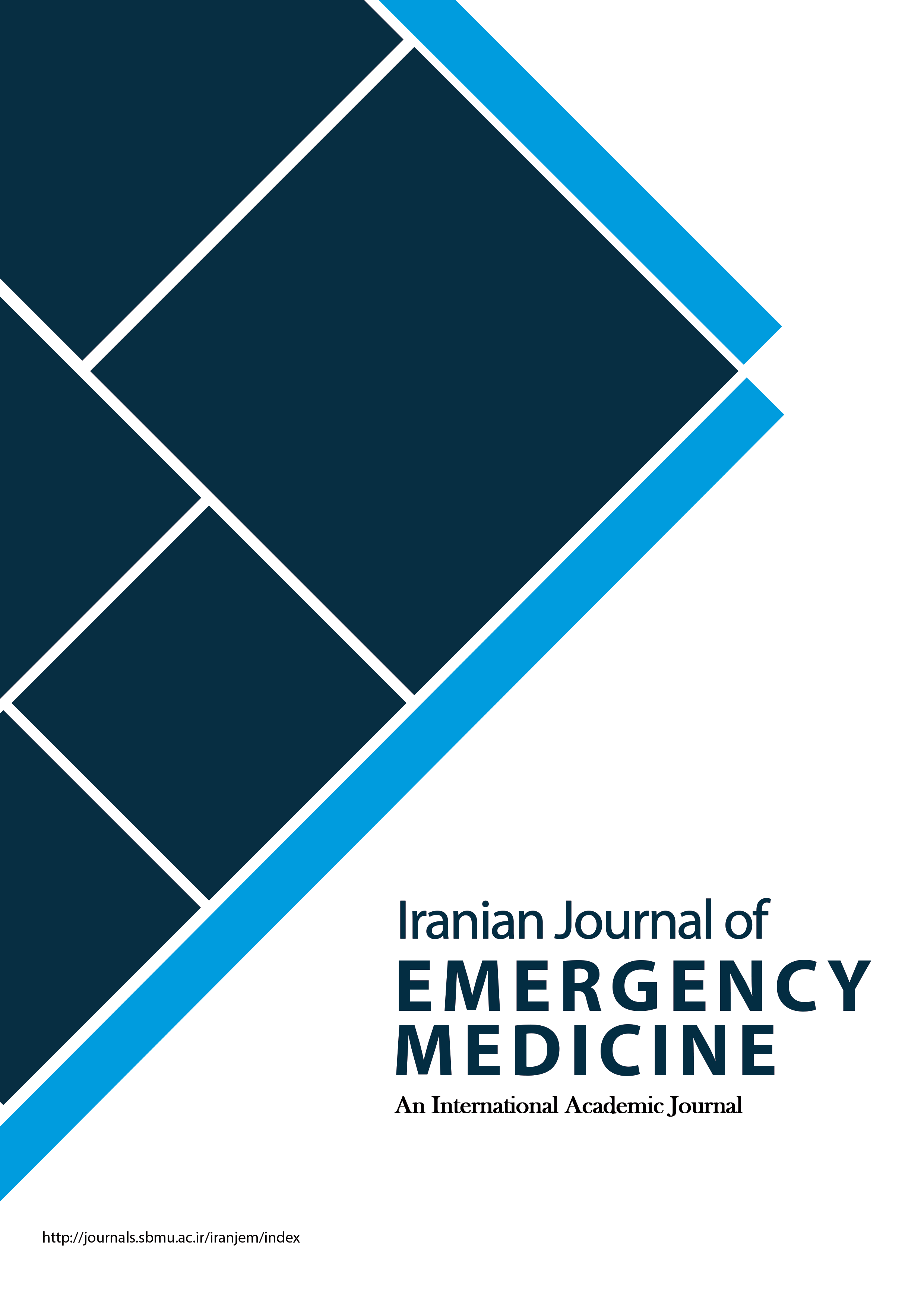The Relationship between Hemoglobin Level and Mortality Rate in Patients with Traumatic Brain Injury Presenting to the Emergency Department of Poursina Hospital in Rasht in 2017
Iranian Journal of Emergency Medicine,
Vol. 9 No. 1 (2022),
16 March 2022
,
Page e22
https://doi.org/10.22037/ijem.v9i1.38641
Abstract
Introduction: Traumatic brain injuries are one of the main causes of death and disability worldwide. Anemia may lead to worse outcomes in patients with traumatic brain injury. Considering that there have been limited studies on the role of anemia and blood transfusion in primary resuscitation of patients with traumatic brain injuries, the purpose of this study was to investigate the relationship between hemoglobin level and mortality rate in patients suffering from this condition.
Methods: This is a retrospective analytical cross-sectional study. The study population consisted of patients with traumatic brain injuries admitted to the emergency department of Poursina Hospital in Rasht, Iran, in 2017. Patients were classified into two groups, according to blood hemoglobin level, anemic (Hb ≤10) and non-anemic (Hb>10). Age, sex, clinical information, treatment measures, duration of hospitalization, and mortality rate in these two groups were recorded and compared. Also, in order to determine the risk factors for mortality in patients with traumatic brain injury, the above variables, along with laboratory findings, were compared in the two groups of patients with survival and death. Data were analyzed using SPSS21 software, and descriptive and inferential statistical tests.
Results: The total number of participants in the study was 297 (249 (83.8%) male and 48 (16.2%) female), with a mean age of 41.8 ± 22.3 years. 120 (40.4%) patients had anemia. Patients without anemia had higher levels of consciousness than those with anemia (P <0.001). There was a statistically significant difference between the anemic and non-anemic patients in terms of the use of vasopressor and patient status at discharge (P <0.0001). The number of packed cells received showed a statistically significant difference between the patients with and without anemia (P <0.0001). Multivariate analysis based on logistic regression model showed that the duration of hospitalization, hypotension, blood transfusion, and hypothermia are risk factors associated with mortality.
Conclusion: The results of this study showed that although anemia is not a predictor of mortality, but blood transfusion is one of the most important factors associated with mortality in patients with traumatic brain injury.
- Anemia
- Brain Injuries
- Traumatic
- Blood Transfusion
- Emergency Service, Hospital
- Mortality
How to Cite
References
Williamson C RV. Traumatic brain injury: Epidemiology, classification, and pathophysiology.2015.
Dewan MC, Rattani A, Gupta S, Baticulon RE, Hung Y-C, Punchak M, et al. Estimating the global incidence of traumatic brain injury. Journal of neurosurgery. 2018;130(4):1080-97.
Kaur P, Sharma S. Recent advances in pathophysiology of traumatic brain injury. Current neuropharmacology. 2018;16(8):1224-38.
Al-Dorzi HM, Al-Humaid W, Tamim HM, Haddad S, Aljabbary A, Arifi A, et al. Anemia and blood transfusion in patients with isolated traumatic brain injury. Critical Care Research and Practice. 2015;2015.
Salim A, Hadjizacharia P, DuBose J, Brown C, Inaba K, Chan L, et al. Role of anemia in traumatic brain injury. Journal of the American College of Surgeons. 2008;207(3):398-406.
Hao Z, Wu B, Wang D, Lin S, Tao W, Liu M. A cohort study of patients with anemia on admission and fatality after acute ischemic stroke. Journal of Clinical Neuroscience. 2013;20(1):37-42.
Malone DL, Hess JR, Fingerhut A. Massive transfusion practices around the globe and a suggestion for a common massive transfusion protocol. Journal of trauma and acute care surgery. 2006;60(6):S91-S6.
Boutin A, Moore L, Lauzier F, Chassé M, English S, Zarychanski R, et al. Transfusion of red blood cells in patients with traumatic brain injuries admitted to Canadian trauma health centres: a multicentre cohort study. BMJ open. 2017;7(3):e014472.
Carlson AP, Schermer CR, Lu SW. Retrospective evaluation of anemia and transfusion in traumatic brain injury. Journal of Trauma and Acute Care Surgery. 2006;61(3):567-71.
McIntyre LA, Fergusson DA, Hutchison JS, Pagliarello G, Marshall JC, Yetisir E, et al. Effect of a liberal versus restrictive transfusion strategy on mortality in patients with moderate to severe head injury. Neurocritical care. 2006;5(1):4-9.
Veenith T, Sharples L, Gerrard C, Valchanov K, Vuylsteke A. Survival and length of stay following blood transfusion in octogenarians following cardiac surgery. Anaesthesia. 2010;65(4):331-6.
Marik PE, Corwin HL. Efficacy of red blood cell transfusion in the critically ill: a systematic review of the literature. Critical care medicine. 2008;36(9):2667-74.
Litofsky NS, Martin S, Diaz J, Ge B, Petroski G, Miller DC, et al. The negative impact of anemia in outcome from traumatic brain injury. World neurosurgery. 2016;90:82-90.
Yee KF, Walker AM, Gilfoyle E. The effect of hemoglobin levels on mortality in pediatric patients with severe traumatic brain injury. Canadian respiratory journal. 2016;2016.
Yang C-J, Hsiao K-Y, Su I-C, Chen I-C. The association between anemia and the mortality of severe traumatic brain injury in emergency department. Journal of Trauma and Acute Care Surgery. 2011;71(6):E132-E5.
Boutin A, Chassé M, Shemilt M, Lauzier F, Moore L, Zarychanski R, et al. Red blood cell transfusion in patients with traumatic brain injury: a systematic review and meta-analysis. Transfusion medicine reviews. 2016;30(1):15-24.
Werner C, Engelhard K. Pathophysiology of traumatic brain injury. BJA: British Journal of Anaesthesia. 2007;99(1):4-9.
Coronado VG, Xu L, Basavaraju SV, McGuire LC, Wald MM, Faul M, et al. Surveillance for traumatic brain injury-related deaths; United States, 1997-2007. 2011.
Sekhon MS, McLean N, Henderson WR, Chittock DR, Griesdale DE. Association of hemoglobin concentration and mortality in critically ill patients with severe traumatic brain injury. Critical care. 2012;16(4):1-7.
Boutin A, Chassé M, Shemilt M, Lauzier F, Moore L, Zarychanski R, et al. Red blood cell transfusion in patients with traumatic brain injury: a systematic review protocol. Systematic reviews. 2014;3(1):1-6.
Bae I-S, Chun H-J, Yi H-J, Bak K-H, Choi K-S, Kim D-W. Modified glasgow coma scale using serum factors as a prognostic model in traumatic brain injury. World Neurosurgery. 2019;126:e959-e64.
LeRoux P. Haemoglobin management in acute brain injury. Current Opinion in Critical Care. 2013;19(2):83-91.
- Abstract Viewed: 142 times
- pdf (فارسی) Downloaded: 111 times



